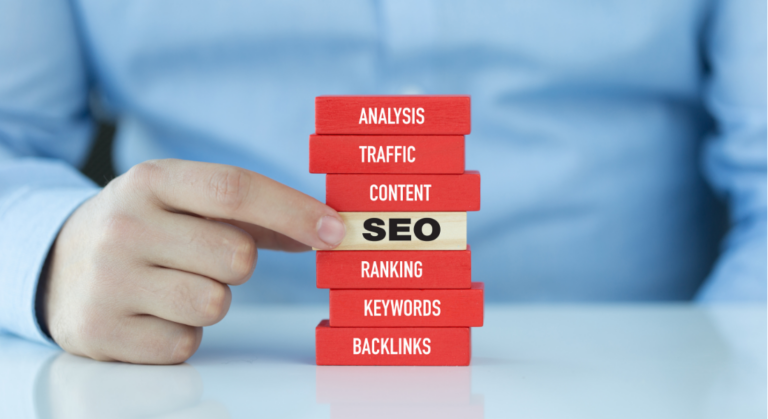Translation and SEO: A Simple Guide
If you have a multilingual website you need to think about multilingual SEO.
This means you need to consider several areas, including:
- International SEO
- Domains, plugins, servers and CDNs
- Equivalent target keywords in your target language
- Website localization
- Directly translated content vs localization or total rewriting of content
It can seem overwhelming…
But whether you are a translation agency or simply someone considering translating your website, our guide should provide some useful knowledge.
What is SEO?
SEO (Search Engine Optimization) is the field of improving the visibility of a website or webpage in a search engine’s results pages (SERPs), i.e., Google’s results pages.
When implemented correctly, it can help increase traffic and engagement with your site.
It can be broken down into three main areas.
1. Technical SEO
Technical SEO is a set of ‘backend’ processes, practices, and strategies designed to improve the visibility of a website in search engine results.
It involves optimizing a website’s code, architecture, server setup, and crawlability (which means how easy it is for search engines to crawl and understand your website).
Technical SEO work can include simple tasks like using software to find and replace broken links (i.e., links to expired pages). Or more complex ones like rewriting code for websites in order to make pages load faster.
Technical SEO work can be carried out by general SEO specialists or dedicated technical SEO experts. They do technical SEO audits of websites and ongoing monitoring and maintenance.
Technical SEO example
A language service provider (LSP) has been losing website traffic lately. This comes despite the fact they have been posting good, SEO-friendly content.
An SEO specialist does a technical SEO audit of their site. He finds the website is loading too slowly for users. He also finds that there are hundreds of links on the site that – when clicked – take the user to a 404 page.
First, he reduces the sizes of most images on the website and then asks a web developer to change the website’s code in order for it to load more efficiently. Then he goes through and replaces the broken links with working ones.
A couple of weeks after his fixes, the website’s traffic increases.
2. On-page SEO
On-page SEO involves optimizing the content of pages on your website for users and search engines. It applies to both blogs and regular website pages (like your home page or individual service pages).
And it includes tasks such as optimizing titles, meta descriptions, headings, images, and keyword usage.
It can also include optimizing calls-to-action (CTAs), design elements, and the flow of information.
What is a keyword?
A keyword is a word, phrase or question that describes the content of a web page and that can be used by search engines to categorize and rank it.
Pages often rank for variations of the same keyword. I.e., translation services and translation service.
They can also rank for related keywords. I.e., translation service in New York and interpretation service in New York.
But generally, to begin with, it’s best to just focus on one keyword per page.
Keyword research tools such as Ahrefs, Semrush, or Moz can estimate how much traffic there is for a given keyword (including what countries that traffic is from). And how easy or difficult it will be to rank a page for it.
On-page SEO example
An LSPs’ website has three pages dedicated to its various services. Their headings are:
- Every Language Combination (for their translation services page)
- Simultaneous and Consecutive Experts (for their interpretation services page)
- Creative Linguists and Copywriters (for their transcreation services page)
An employee does some keyword research. She finds that no one is searching for these specific phrases.
However, she discovers other relevant terms that have traffic:
- Translation Services
- Simultaneous and Consecutive Interpretation Experts
- Transcreation Services
These new headings more accurately reflect what search engine users are using.
Once the pages have been changed to include these keywords, they start to rank for these terms and bring relevant traffic.
3. Off-page SEO
Off-page SEO is everything concerned with improving the visibility of a website in search engines by increasing external signals pointing to it.
It involves activities such as link building, content promotion, and (to a lesser degree) social media activities.
Off-page SEO work is based around promoting content, creating relationships, and building authority. Its main task is backlink outreach.
What is a ‘backlink’?
A backlink is simply an incoming link from one web page to another website.
For example, imagine a translation news website mentions your company. In that mention, it adds a link to your home page. This is a backlink.
Some users will click on the link and go to your site. But the main benefit is that backlinks are seen by search engine algorithms as votes of confidence for the linked-to website.
But it isn’t as simple as getting more backlinks to your website in order to be able to rank higher…
Some backlinks are more valuable than others. A link from an authoritative website (like BBC.com, for example) is worth more than a link from an obscure website.
And bad, spammy backlinks can cause Google to penalise your site.
In general, backlinks need at least two of the three main attributes:
- Relevance: Being related to your industry or niche
- Traffic: The page or domain they are from gets a lot of traffic
- Authority: The page or domain they are from itself has a lot of backlinks from other authoritative domains
Off-page SEO example
A localization website is not ranking as high in search results as its competitors. They decide to run a backlink campaign to improve their website’s authority.
They begin by making a list of all the publications that are focused on translation and localization.
Next, they rank these publications in order of how authoritative each one’s domain is (according to estimates from SEO software).
Then, they contact each domain with a pitch for a featured article in exchange for a backlink. Each successful pitch earns them a backlink.
What is SEO translation (/translation for SEO)?
So far, we have looked at SEO broadly speaking.
We have given examples related to translation and localization services. But the principles underlying them apply to all industries.
However, whether it’s for your own business’s website, or a client’s, understanding how translation and SEO are related is useful and potentially profitable.
So, when you go through the website translation process, the following points need to be considered.
1. What is international SEO?
International SEO is the area of SEO focused on target audiences in different countries, regions, cultures and (often but not always) languages.
It is not the same as SEO for translation, but they are linked.
International SEO strategy involves optimizing a website’s content, structure, and links to be more visible in search engine results in different countries.
This type of SEO requires careful consideration of technical, on-page and off-page signals. It requires making it very clear to search engines which page to show to users in which location.
One of the main ways to do this is with hreflang attributes.
What are hreflang attributes?
Hreflang is an HTML attribute for setting the language and geographical targeting of a webpage.
In other words, it’s a line of code that goes at the top of a webpage which tells search engines: this page is in the French language and is for users in France.
It can be even more specific than that. It could declare: this page is in French and is for users in French-speaking Canada. Likewise, it can assign pages in English for England, Ireland, the US, Australia, etc.
You can have multiple languages available on your website, but that doesn’t ensure that search engines will deliver the right page. If users can’t quickly find the right page themselves, they might simply give up and go to your competitor.
Once hreflang has been implemented correctly, it allows search engines to deliver the right page to the right audience.
So a user in Brazil, for example, will get one result (www.mywebsite.com/br/), and a user in Poland will get another (www.mywebsite.com/pl/).
Each will feature the most relevant currencies, deals, estimated delivery times, contact information, etc.
So, having the correct hreflang attribute on your website will not only help its search performance in different countries, but it will also likely increase your conversion rates.
Though this all sounds simple on the surface, the topic is widely seen as a complicated and difficult one. Implementing it is particularly difficult for larger websites with multiple languages.
2. Creating pages vs websites for different languages
One of the first questions that people who consider translating websites ask is: shall we create a multilingual website on the same domain or start a totally new website on a new domain?
The answer to this is the most common cliché in SEO today: It depends.
If you are fully committed to entering a new market and have the resources, then creating a whole new domain could have its benefits.
Namely, you wouldn’t need to worry about hreflang mistakes, a multilingual XML sitemap, or lost users ending up on the wrong pages.
But you also won’t be able to transfer authority across to your new site in the way you would if you were to simply create new pages on the same domain.
In some cases, you might only want to translate a few pages of your domain, in which case it is not worth starting up a new website.
And modern content management systems (CMS) such as Hubspot do make replicating and editing new pages on a multilingual website relatively simple.
Website servers
Choosing the right server and/or CDN is an important part of an international SEO strategy.
Servers are powerful computers with specialized software installed that allows them to communicate with and respond to requests from other computers.
In other words, they are where webpages, files, data, or applications are stored.
Some servers are better (faster, more secure) than others. They can influence how fast and stable your website is. If you choose a bad one, you could damage the SEO and user experience of your website.
Content Delivery Networks (CDNs)
With the rising sophistication and popularity of Content Delivery Networks (CDNs), the physical location of your server is getting less important.
A CDN is a distributed network of servers that delivers web content to users at high speeds.
It stores a copy of the website’s content in multiple locations around the world, allowing it to be delivered faster and more reliably than if served from a single location.
3. Multilingual keyword research
When you conduct keyword research, there are four things to consider:
- Relevance: How relevant is the traffic from this keyword likely to be to my website?
- Search intent: What is the user looking for – a blog or a commercial page?
- Search volume: How frequently is this keyword searched? (Usually given per month based on an annual average)
- Keyword difficulty: How easy or difficult is this keyword to rank for? (This does not mean how easy it is to create a page for that keyword)
Translating keywords is not as straightforward as many might think. A keyword with a lot of search volume in English, for example, might have a low search volume in Spanish, or vice versa.
For example, there might be a lot of search traffic related to fake tan products in the UK, but almost none in Spain.
When you are translating a website’s content, you need to consider which pages are worth translating. And which are not.
Ideally, you would try and find an equivalent keyword in the target language. If you can, you need to rewrite that content for the target language.
SEO translation process: Local vs international competitors
Translated content alone will not often be enough to ensure you will rank in the new language.
Whether it’s for one of your main domain’s pages (like the home or a service page) or a blog, you always need to check what is currently ranking for your target keyword.
A big part of any SEO strategy, including a multilingual SEO strategy, is selecting which search engine rankings to research when you are translating or writing content.
Localized content example: history of architecture
Imagine your client has an English-language blog page that ranks first for the keyword ‘history of architecture‘.
You manage to find the equivalent German keyword (Geschichte der Architektur). However, the top-ranking blogs in Germany for this keyword give three quite different blogs to the top-ranking ones in English.

Besides the language, they also discuss different points about the subject and give more German cultural references. Your English article focuses more on US and UK architecture and history.
Will your directly translated content rank in German? Possibly. But you also might need to localize or even re-write it to better appeal to a German audience.
Translated content example: history of cats
In other situations, you might have an advantage by more or less directly translating your content.
For example, your client, a pet food retailer, ranks first for the keyword ‘history of cats’ in English. This keyword has approximately 3000 searches per month.
They want to translate their website into Spanish. The equivalent keyword (historia de los gatos), has only half of the search traffic and much easier keyword difficulty.

Your writer (or SEO translator) reads the top three English blogs for this keyword and the top three Spanish ones.
They notice that the English-language ones happen to be longer and more in-depth than the Spanish-language ones. But other than language, the cultural differences between the articles appear to be slim to none.
So by simply translating the content more or less word for word, the original English-language blog translated into Spanish comes out longer and more in-depth than its Spanish competitors and ranks first.
4. Different search engines
Google has 84% of the world’s global search engine market share.
But it isn’t the most popular search engine everywhere. Three other search engines in particular, stand out as dominating other markets:
- Baidu (China)
- Yandex (Russia)
- Naver (South Korea)
Each of these has its own algorithm, which means it will require different SEO tactics.
Outside of experience and knowledge of these, hiring a local expert to help is the best solution.
5. Automated translation vs SEO localization
The future of translation looks uncertain. There is increasing talk of machine translation services replacing human translators.
At present, there are translation plug-ins that can automate the translation of your website. Google Translate can also give accurate translations of websites.
However, plug-ins often give word-for-word translations. This is useful sometimes, but other times you might need a totally different page in one language.
If your goal is simply to create an exact literal translation of some or all pages, then an automated translation is the most efficient option (either via a plugin or using machine translation services to translate each page).
You can always asses the new pages’ search performance in the target market and then revisit them later on.
However, if your goal is to maximize your SEO and conversion rates in a target country right away, using a professional SEO translator is essential. Or you could use an SEO expert working in conjunction with professional translators and translation project managers who can maintain the translation quality assurance process.
6. Design
Different languages have different spacial requirements. This applies to equivalent and literal translations.
For example, take the following popular Chinese idiom:
- 入乡随俗
- Literal translation: Enter village follow customs
- Equivalent translation: When in Rome, do as Romans do
Chinese is perhaps a relatively unique and striking example to give. But the same principle applies to other languages:
- Harry Potter and the Deathly Hallows – Part 1
- Harry Potter und die Heiligtümer des Todes – Teil 1
Here, the German version of the title is both longer overall and has a higher word and character count.
Because of this, the look and feel of a translated webpage will likely change at least a bit from the original language version.
Furthermore, there are other cultural differences to consider. One example is the fact that East Asian websites often have a busier and more information-rich appearance.
All of these design features will have an impact on your brand.
They will also affect the user metrics of your page (i.e., the bounce rate and how users interact with it), which in turn will impact your SEO.
In other words, if Google sees that users who land on your page often leave it and go back to the results to select a different answer (sometimes referred to as ‘pogoing’), it might assume your page is not great and reduce its ranking position.
Conclusion
Simply translating your website and not worrying about SEO could be useful if you simply have a small local audience in mind. Especially one that will likely find you via your brand name.
However, it would be a waste of effort if you are hoping to gain new organic search traffic. And a missed opportunity if you really want to grow in that market.
If your website doesn’t rank for any keywords, and no one has heard of your brand, no one will be able to find it via search.
SEO translation services and international SEO are not the same thing, but they are closely linked.
Issues such as hreflang attributes, servers, CDNs, and different search engines (if applicable) need to be considered.
Your translation process should take into account equivalent keywords in the target language. Directly translated versions of existing content are ok (or even favourable) in some situations.







